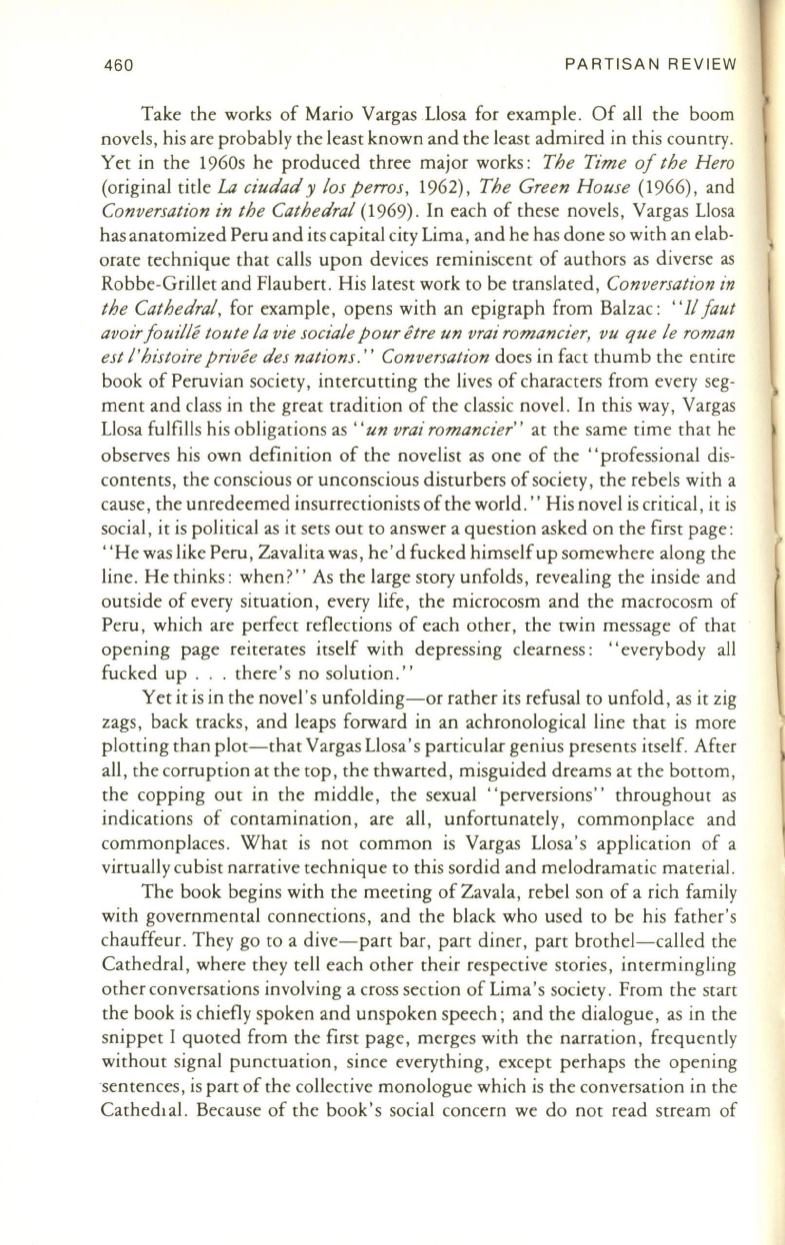
460
PARTISAN REVIEW
Take the works of Mario Vargas .Llosa for example . Of all the boom
novels, his are probably the least known and the least admired in this country.
Yet in the 1960s he produced three major works :
The Time oj the Hero
(original title
La
ciudad
y
los perros,
1962),
The Green House
(1966) , and
Conversation in the Cathedral
(1969) . In each of these novels, Vargas Llosa
has anatomized Peru and its capital city Lima, and he has done so with an elab–
orate technique that calls upon devices reminiscent of authors as diverse as
Robbe-Grillet and Flaubert . His latest work to be translated,
Conversation in
the Cathedral,
for example, opens with an epigraph from Balzac:
" II Jaut
avoirJout/le toute la vie sociale pour etre un vrai romancier, vu que Ie roman
est I'histoire privee des nations." Conversation
does in fact thumb the entire
book of Peruvian society, intercutting the lives of characters from every seg–
ment and class in the great tradition of the classic novel. In this way, Vargas
Llosa fulfills his obligations as
" un vrai romancier"
at the same time that he
observes his own definition of the novelist as one of the "professional dis–
contents, the conscious or unconscious disturbers of society, the rebels with a
cause, the unredeemed insurrectionists of the world ." His novel is critical, it is
social, it is political as it sets out to answer a question asked on the first page :
"He was like Peru, Zavalita was, he 'd fucked himself up somewhere along the
line. He thinks : when?" As the large story unfolds , revealing the inside and
outside of every situation, every life, the microcosm and the macrocosm of
Peru, which are perfect reflections of each other, the twin message of that
opening page reiterates itself with depressing clearness: "everybody all
fucked up ... there's no solution."
Yet it is in the novel's unfolding-or rather its refusal to unfold, as it zig
zags , back tracks, and leaps fotward in an achronological line that is more
plotting than plot-that Vargas Llosa' s particular genius presents itself. After
all, the corruption at the top, the thwarted, misguided dreams at the bottom,
the copping out in the middle, the sexual "perversions" throughout as
indications of contamination, are all, unfortunately, commonplace and
commonplaces . What is not common is Vargas Llosa's application of a
virtually cubist narrative technique to this sordid and melodramatic material.
The book begins with the meeting of Zavala, rebel son of a rich family
with governmental connections, and the black who used to be his father 's
chauffeur. They go to a dive-part bar, part diner, part brothel-called the
Cathedral, where they tell each other their respective stories, intermingling
other conversations involving a cross section of Lima's society. From the start
the book is chiefly spoken and unspoken speech ; and the dialogue, as in the
snippet I quoted from the first page, merges with the narration, frequentl y
without signal punctuation , since everything, except perhaps the opening
sentences, is part of the collective monologue which is the conversation in the
Cathedlal. Because of the book's social concern we do not read stream of


